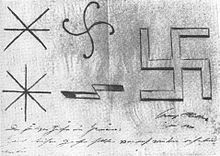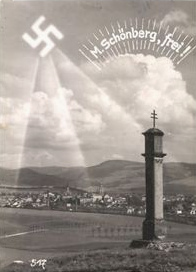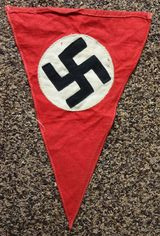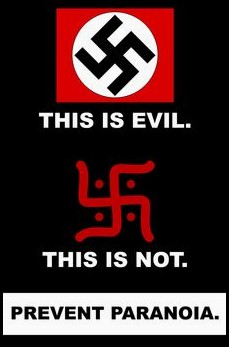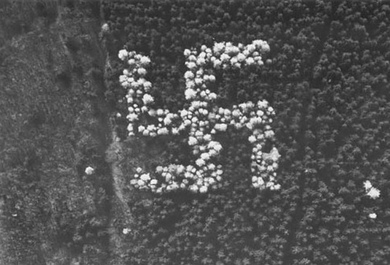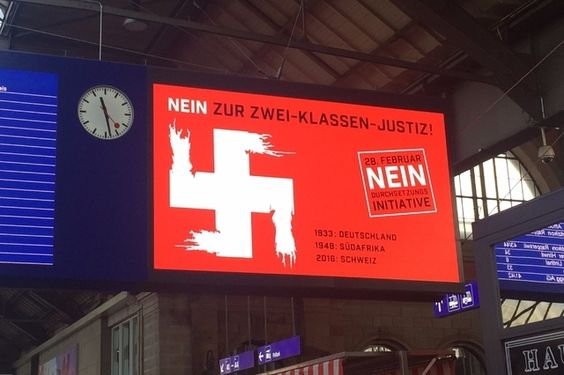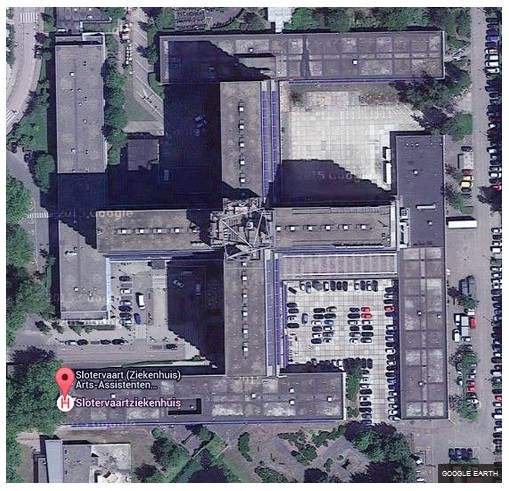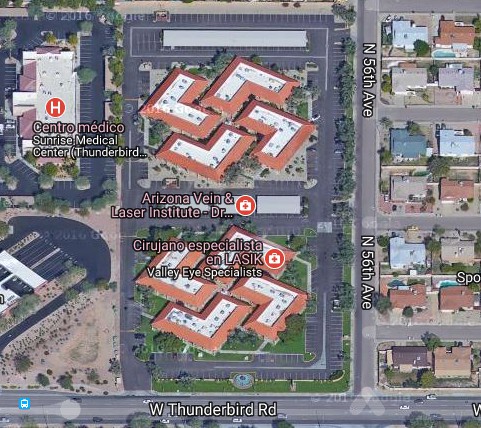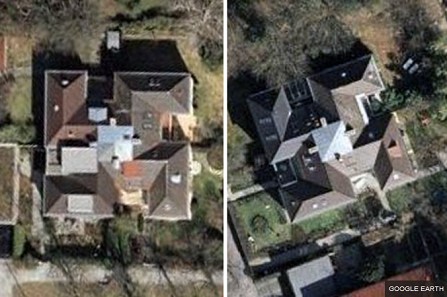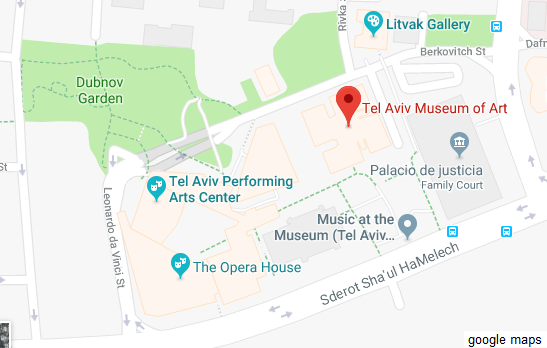Navajo
aborigine, swastika as a symbol of Navajo's creation story in the
center of a cloth pattern [3] - on a headband [4] - on a dress, worn by
Jacqueline Kennedy Onassis [5] - on a rug [6]
Navajo
native weaving a rug with swastikas [12] - swastikas in a carpet [13] -
swastika in a weaving [14] - basketball team with natives (navajo?) in
the 1920s with swastika shirts [15]
7. Europe: Swastika among the Teutons: Odin

Teutons: swastika of Odin with sun around [22]
8. India: Swastikas (Swastikas) in Hinduism as a "good luck charm" or "promise"
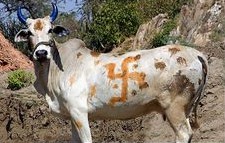
Hinduism with swastikas (swastikas as symbols of happiness and good life) painted on a cow, India [23]
India: Swastika = "it brings well-being" - "lucky charm" - "promising object"
The next website claims that the swastika is said to have been around
since 2553 BC. exist (Tibet seems unknown here). The Indian Sanskrit
word "swastika" can have different meanings: well-being, good luck, or
promise [web02].
Original:
"The word swastika is derived from the Sanskrit,
meaning any lucky or auspicious object, and in particular a mark made on
persons and things to denote good luck.
It is composed of "su" - meaning "good, well" and asti "to be" svasti
thus means "well-being". The suffix -ka either forms a diminutive or
intensifies the verbal meaning, and svastika might thus be translated
literally as
-- "that which is associated with well-being", corresponding to
-- "lucky charm" or
-- "thing that is auspicious"." [web02]
|
Further information about the swastika in Hinduism goes much further:
-- In Hinduism the symbol of the Swastika comes as second only after the
first one, Om, and this swastika symbol is used in the beginning of
almost all religious celebrations, embodies the rotating forward motion
of the sun and means joy, light and life
-- In the Vedas (Dharma) the swastika is a wheel with four spokes, and
the hook lines symbolize the rotation or the ceremonial fire yajna - the
swastika "marks in the Vedas the Sun God
Surya, in the
Puranas the
chakra of the god
Vishnu and one of the eight
yoga seats - and: the swastika is also the sign of the god
Ganesha
-- the swastika symbolizes the eternal cycle of birth and death (Samsara)
-- The swastika is considered a sign of reincarnation
-- A swastika is considered a promise of happiness at festivities
(weddings, etc.) to worship the goddess of luck: Lakshmi [web01].
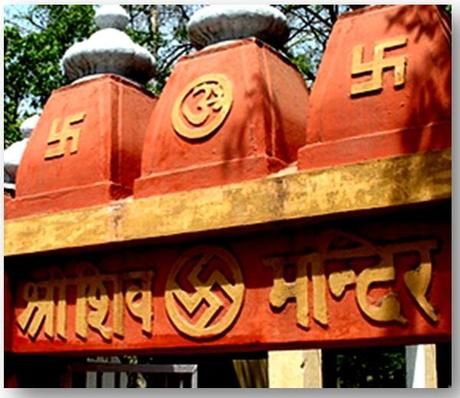


Hinduismus mit Hakenkreuzen (Swastikas als Glückssymbole) an einem Tempeleingang, Indien [24] -
im Zentrum einer Tempeldecke, Jaipur, Rajasthan, Indien [25] - an den
Seiten von Ganesha, Indien [26]
Hinduism with swastikas (swastikas as symbols of happiness) at a temple
entrance, India [24] - in the center of a temple ceiling in the town of
Jaipur, province of Rajasthan, India [25] - at the sides of Ganesha,
India [26]
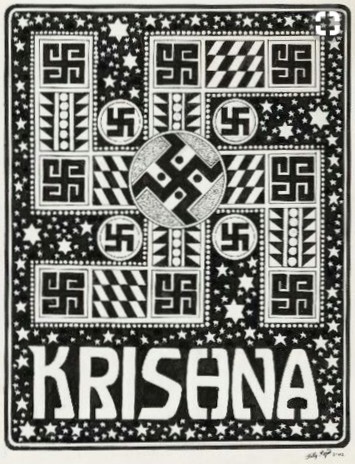
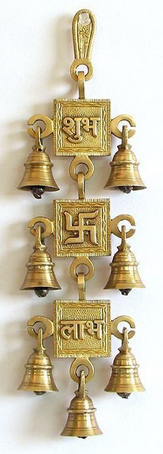
Hinduism with swastikas (swastikas as symbols of happiness) in a Krishna pattern [27] -
India, bell-tree with swastika (Swastika as a sign of truth and eternity) [28]
- The "left-angled form" is said to have negative energy
("counterclockwise in the view of populations in India"), according to
certain circles, to have a negative effect, to be the symbol of the
goddess Kali and provoking sunset, decline of life, night, mischief and death [ web01].

Hinduism: Shrine with the goddess Kali with swastika, certain circles in the Indian culture say
this would be in the negative direction, town of Varanasi, India [29]
9. India: Swastika in Jainism as a sign of creation
Jainism: rules of life with points and swastika [30] - represented in one person [31] - Jainism: Mahavira with swastikas [32]
The swastika in Jainism
- represents the creation with a four-part world: Gods (Heaven) - People - Animals - Underworld (Hell)
- humanity should be divided into four parts: monks, nuns, male lay people, female lay people
- represents the four infinite characteristics of the soul: knowledge, perception, happiness, energy [web01].
The swastika is also the symbol of the seventh of 24 "
Tirthankara" [web01].
Since 1974, the symbol is accepted by all Jains and is a basic representation of the learning systems [web01].
10. China and Southeast Asia with Buddhism: swastika (wan) symbolizing happiness, abundance, prosperity, long life - and the sun
In China, swastikas are called "wan" and are symbolizing happiness,
abundance, prosperity, long life, infinity. Combined with the character
of "fu" for a bat (chiroptera), "ten thousandfold luck" is interpreted.
Empress Wu Zetian then explained the sign "wan" in a circle symbolizing
the "sun". Rooftops of Buddha temples are decorated with swastikas. On
maps, Buddha temples are marked with a swastika [web01].
Buddhist swastikas (as symbols of happiness) in a
meditation rug in Tibet [33] - in the center of a pattern of flowers
[34] - as an ornament at the Shaolin Monastery, China [35] - as an
ornament at the Kuta Bali Temple [36]
Buddhism with swastika (swastika as energy vortex
for creation) in the center of a mandala [37] - in an "eternal knot" in
an ornament on a cupboard [38] - Buddhism with swastika (Swastika as
energy vortex or lucky symbol) combined with the sign of "Om" [39]
Buddhism with swastika (as lucky symbol, vortex of energy of creation or eternity), 8 pieces in one door, China [42] -
Grave urn with Vedic swastika, China [43]
Swastikas on Chinese Buddha figurines are a sign of the heart of Buddha or of Buddha nature. In the Song dynasty (960-1276), the swastikas on Chinese Buddha statues appear not only on the forehead, but also on the chest, on the hand or on the heels [web01].

Buddha with swastika (Swastika as a sign of the heartfelt Buddha nature) on the chest [44]
11. Nestorian: Swastika = sun, fire, light
"In Nestorian art, the swastika symbolizes the turning sun, the fire or the light." [web01]
(original German:
"In nestorianischen Kunstwerken symbolisiert die Swastika die
sich drehende Sonne, das Feuer oder das Licht." [web01])
12. Where do the rattlesnakes in swastika form belong to?

Where does the swastika with the swastika in form of rattlesnakes belong? Means renewal [45]
13. Swastikas in Ancient Cultures of Western Asia
14. Swastikas in Europe: vessels and objects: symbol of mediation between heaven and earth - or fire
Ancient Greece: swastika - the mediator symbol and symbol for fire
"In ancient Greece, the swastika [...] was a symbol that connects heaven
and earth, with the right arm pointing to the sky and the left to the
earth." [WEB05]
Another website says that in ancient Greece the swastika was the symbol of the fire [web06].


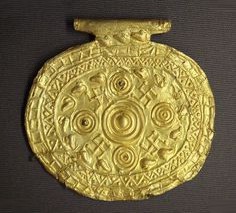

In
ancient Greece, the swastika should also have been the symbol of the
fire [50] - Greek goddess Artemis with a double swastika, Crete, 900 BC.
[51] - Pendant with swastikas, Etruscans 700 BC. [52] - Greek vase with
swastikas [53]




Greek-Roman vase with a swastika (Swastika as a sign of the union of heaven and Earth, or the fire) [54]
Greek-Beotic bowl with swastika (swastika as a sign of the connection between heaven and earth, or fire) [55]
Greek-Minoan gold bowl with swastika (swastika symbolizing the connection between heaven and earth, or fire) [56]
Greek helmet with swastikas (swastika symbolizing the connection between heaven and earth, or fire) [57]
The new meander technique in Greek ornamentation with swastikas
From 900 BC the meander ornaments are used, which automatically create swastikas:
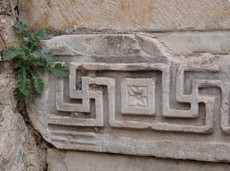
Ephesus, swastikas in temple ornaments showing meanders [58], from 900 BC. [web07]
"It was used by the Phoenicians as a symbol of the sun and it was used as a sacred symbol by the priestesses." [web05]
(original German: "Es wurde von Phöniziern als Symbol der Sonne verwendet und es wurde
als ein heiliges Symbol von den Priesterinnen verwendet." [web05])
16. Swastikas on coins
The swastikas in the meander ornaments
Greek antiquity invented the meandering ornaments, where swastikas are formed automatically:
7,000-year-old coins with swastikas (swastikas, symbol of the union of heaven and Earth, or the fire) [59]
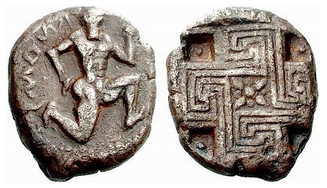

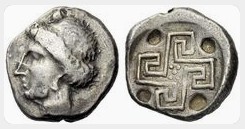
Coin,
sporty man with buffalo head and swastika on the back [60] - swastika on
a coin with a flying horse, Corinth, Greece - swastika here is a
stylized, flying horse [61] - swastika on a coin with Ariadne, Knossos,
Crete, 450-375 BC. [62]
17. Swastikas in Ancient Greece in ancient floor mosaics
As the new research proves (
Zillmer: Columbus came last, oroginal German: Kolumbus kam als Letzter),
the Roman Empire is an invention of the Rome Church to make Rome a
"great past" and to promote the gay and criminal Vatican. In reallity as
"Romans" were called Greek soldiers abroad. And there is another
reality: Ancient Greek is Old High German. So if a mosaic is called
"Roman", then it is to be understood to be from a later Greek time.


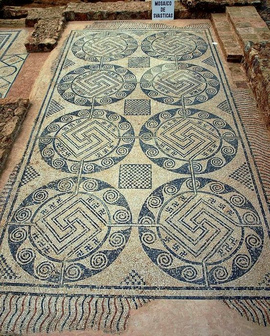
Swastikas
(swastikas as symbols of the connection between heaven and earth, or
fire) in a mosaic in a "Roman villa", Valladolid, Spain [63] in Nîmes,
France [64] - in a mosaic in a "Villa Romana de Tejada in Quintanilla de
la Cueza in the province of Palencia, Spain [65]


 Swastikas (swastikas as symbols of the connection between heaven and earth, or fire)
Swastikas (swastikas as symbols of the connection between heaven and earth, or fire) in mosaics in Pompei 1,2,3 [66,67,68]
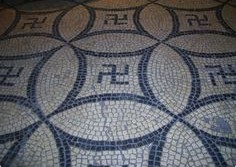
 Swastikas
(swastikas as symbols of the connection between heaven and earth, or
fire) in a "roman" (late Greek) mosaic in Cologne [69] in Hadrian's
mension [70]
Swastikas
(swastikas as symbols of the connection between heaven and earth, or
fire) in a "roman" (late Greek) mosaic in Cologne [69] in Hadrian's
mension [70]
18. Antique waystones with swastikas
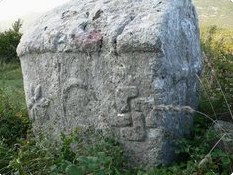
Bosnia, milestone with swastika (swastikas as symbols of the connection between heaven and earth, or fire) [71]





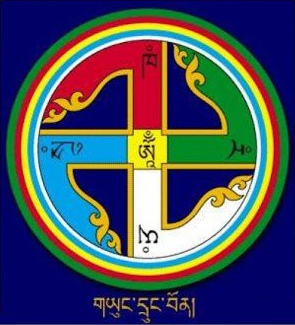
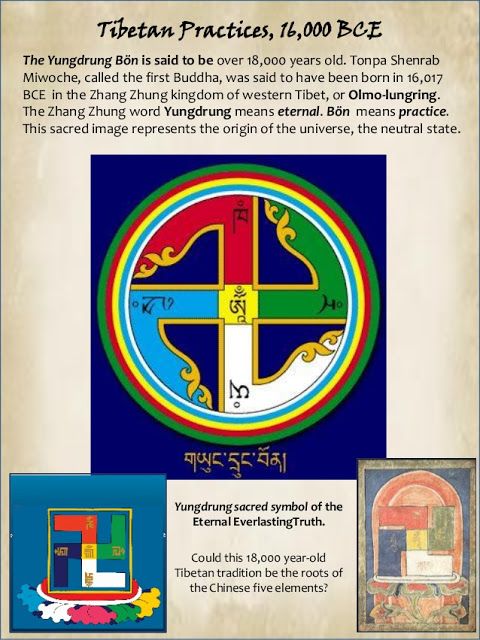 [1a]
[1a]
 [2]
[2]

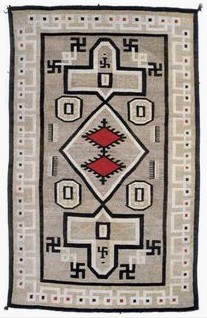

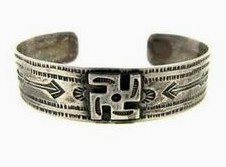

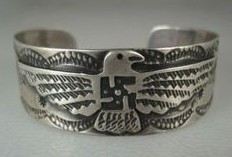
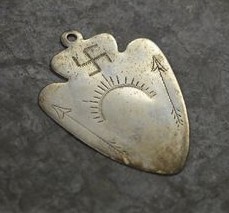

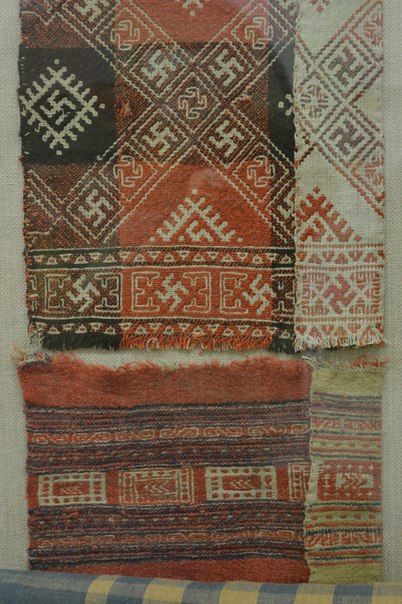






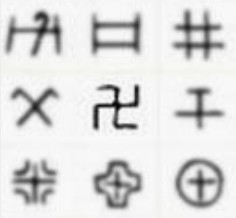




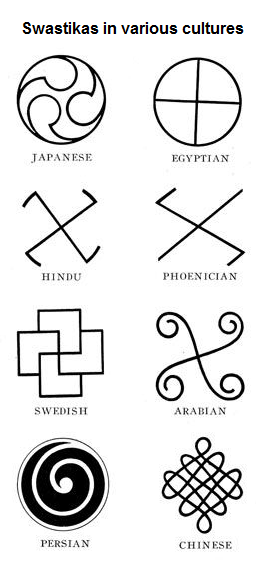



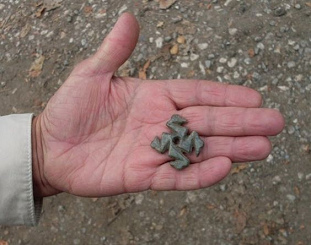








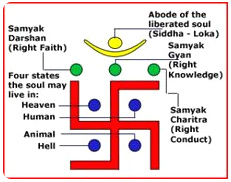
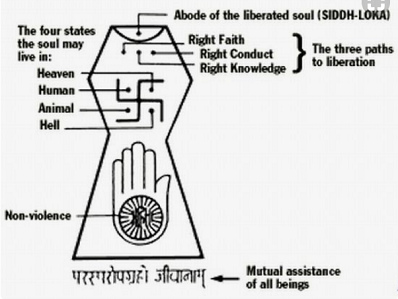



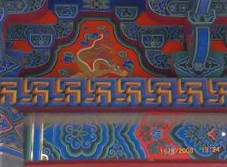






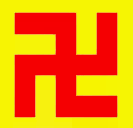




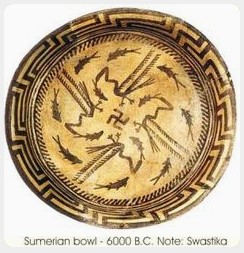



























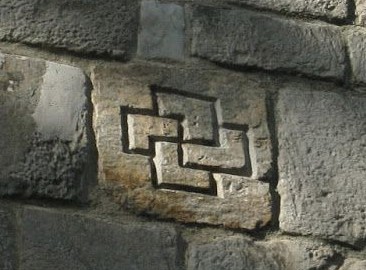
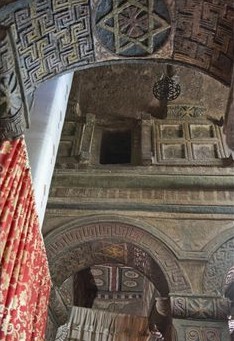






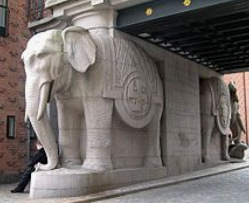
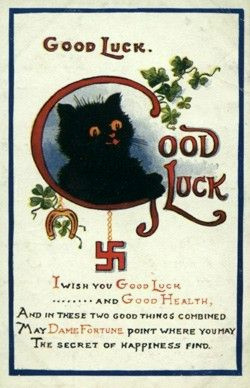


![England: Münze der Pfadfinder "Boy Scouts" mit Hakenkreuz (Swastika als Glücksbringer) mit der Aufschrift: "Viel Glück" ("Good luck") [94] - England: Münze der Pfadfinder "Boy Scouts" mit Hakenkreuz (Swastika als Glücksbringer) mit der Aufschrift: "Viel Glück" ("Good luck") [94] -](../D/01-uebersicht-d/086-GB-muenzanhaenger-pfadfinder-boy-scouts-m-gr-hakenkreuz-swastika-1910.jpg)




